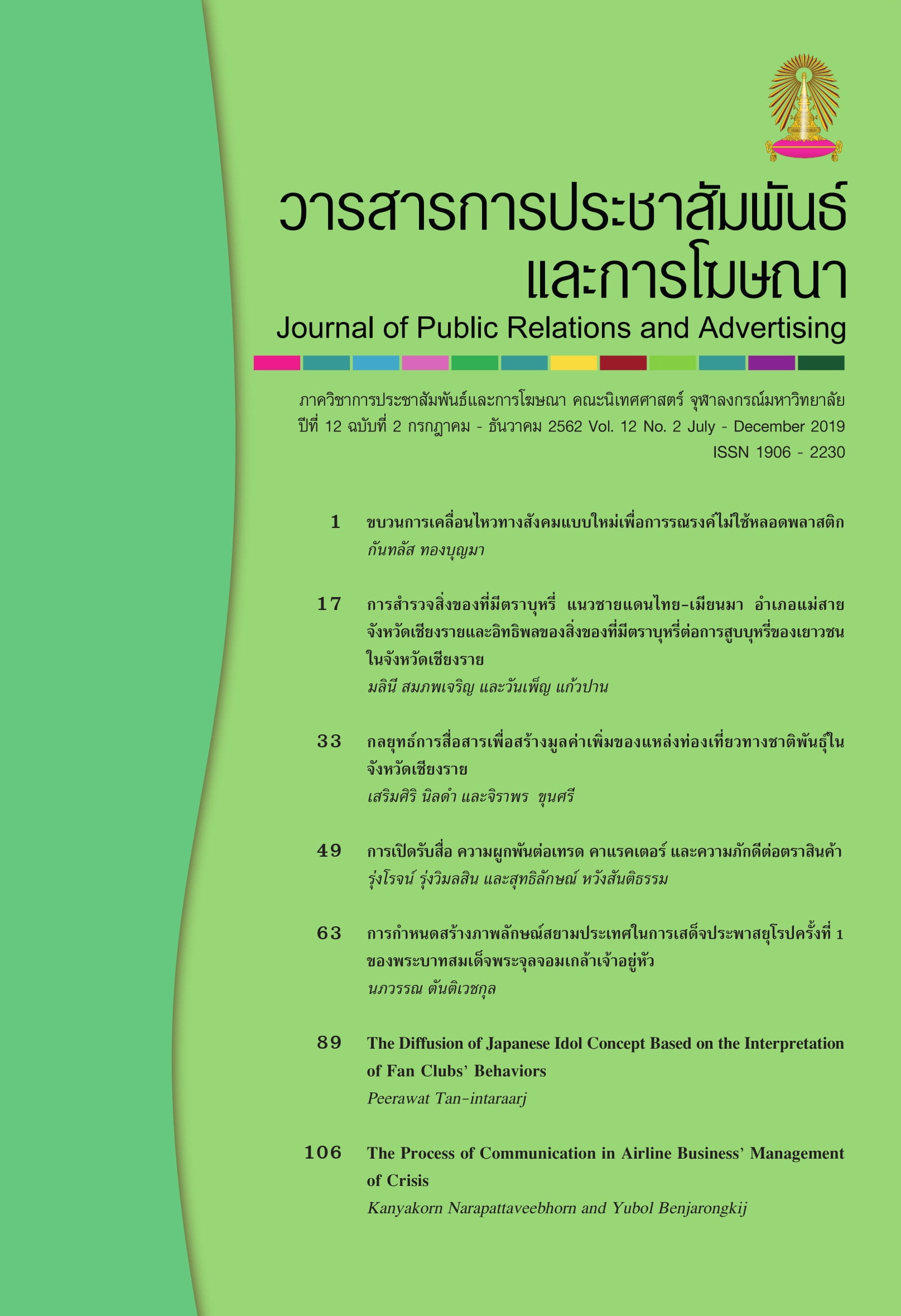The Communication Process in Airlines’ Crisis Management
Main Article Content
Abstract
T
he objective of this research is to study airlines’ crisis communication, before,
during and after a crisis. The research is conducted using a mixed-method that combines quantitative and qualitative approaches. The study consists of two parts. The first focuses on the Public Relations (PR) of value of airlines during 2010-2014 by collecting data of airlines’ PR value from newspapers. The second part involves in-depth interviews with airline executives and staff as well as crisis communication management experts in social media.
The results of part one show that the three highest number of airline PR values were found with Thai Airways, Air Asia and Bangkok Airways. The in-depth interviews in the second part present the airlines’ crisis communication management activities during different time periods. To prepare, prior to a crisis, they will prepare a crisis plan, communication tools and connections; train employees; simulate the plan; form a crisis team and practice safety drills. During a crisis, actions included implementing crisis analysis and management, data collection, arranging internal meetings to give updates, establishing a PR operation center, determining targeted audiences, choosing content designs and communication tools, controlling news sources and providing media updates. Finally, following the crisis, the procedures consisted of crisis summary, situation recovery and crisis management evaluation.
Article Details
References
Bland, M. (1998). Communicating out of a crisis. Houndmills, Basingstoke, Hampshire: Macmillan Business.
Coombs, W. (2007b). Crisis management and communication. Retrieved July 3, 2018, from http://www.instituteforpr.org/essential_knowledge/detail/crisis_management_and_communications/
Coombs, W. T. (2011). Ongoing crisis communication: Planning, managing, and responding (3th ed.). Thousand Oaks, CA.: Sage.
Coombs, W. T., Sherry L. Holladay (2010). The Handbook of crisis Communication. Blackwell Publishing Ltd: UK.
Duangtip Worapan. (2002). Public relations in crisis. Bangkok: Tewa Creation Company Limite.
Gonzalez-Herrero, A., & Smith, S. (2008). Crisis communication management on the web: How Internet-based technologies are changing the way public relations professionals handle business crises. Journal of Contingencies and Crisis Management, 16(3), 143-153.
Guth, D. W. (1995). Organizational crisis experience and public relations roles. Public Relations Review, 21(2), 123-136.
Heath, R. L. (2010). Crisis communication: Defining the beast and de-marginalizing key publics. In W. T. Coombs,&S.J. Holladay (Eds.). The handbook of crisis communication. (pp. 1-13). Chichester: Wiley-Blackwell.
Liu, B. F., Austin, L., & Jin, Y. (2011). How publics respond to crisis communication strategies: The interplay of information form and source. Public Relations Review, 37(4), 345-353.
Pannavach Pichaibavornphat. (2017). Strategic Crisis Communication Management in Digital Era Case Study Airline Business: United Airline, Air Asia, and Nok Air. Bangkok: Bangkok University.
Pearson, C. M., & Clair, J. A. (1998). Reframing Crisis management. Academy of Management Review, 23(1), 59-77.
Rapp, A., Beitelspacher, L. S., Grewal, D., & Hughes, D. E. (2013). Understanding social media effects across seller, retailer, and consumer interactions. Journal of the Academy of Marketing Science, 41(5), 547-566.
Safflr, Leonard., and Tarrant John. (1992). Power Public Relations How to Get Work for you. Illinois: NTC Business Book Publishing Group.
Sirintorn Mahamontri. (2004). Public relations strategic plan: A case study of the ministry of public health’s severe acute respiratory syndrome (SARS) (Unpublished master’s thesis). Thammasat University, Bangkok.
Tan, Ee Ling J. (2003). Singapore airline: A case study in exemplary crisis communication (Unpublished master’s thesis). Wichita State University, Wichita, USA.
Ulmer, R. R., Sellnow, T. L., & Seeger, M. W. (2007). Effective crisis communication: Moving from crisis to opportunity. Thousand Oaks, Los Angeles: Sage.
Van Dijk, J. (2012). The network society (3 ed.). London: SAGE Publications Ltd.
Wilcox, D. (1994). The guide to effective participation. Brighton: Delta Press.
Wilcox, Dennis L, Ault, Philip H., & Agee, Warren K. (1998). Public relations strategies and tactics. New York: Longman.
Wright, Donald K., and Michelle D. Hinson.(2009) Examining how public relations practitioners actually are using social media. Public Relations Journal 3(3), 1-33.


